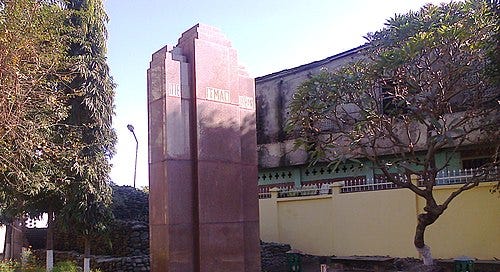India’s Liberation Day April 14th, 1945
Lt Col.Shaukat Aziz Malik hoists I.N.A. flag for the first time on mainland India
Indian National Army led by Subhas Chandra Bose and the Imperial Japanese Army started liberating Indian land from the British in 1944/5 after entering India from the Northeastern Side of India from Burma (Myanmar).
They met with instant success. Bose said: ‘Comrades, officers and men of India’s Army of Liberation. Let there be one solemn resolve in your hearts -Either Liberty or Death and let there be but one slogan on your lips- Onwards to Delhi. The road to Delhi is the road to freedom. This is the road along which we must march. Victory will certainly be ours.’
Shah Nawaz Khan described the scene when I.N.A. reached Indian soil for the first time: ‘Soldiers laid themselves flat on the ground and passionately kissed the soil of their motherland they had set out to liberate. A regular flag hoisting ceremony was held amongst great rejoicing and singing of Azad Fauz's national anthem.’
Lt Col.Shaukat Malik of the Indian National Army hoisted the Indian National Army flag .
‘On the morning of April 14th, when Manipuri were celebrating their New Year festival, the activists in Moirang heard that Indo-Japanese troops led by Captain Ito entered Moirang. They were welcomed by M.Koireng Singh ( who later became Chief Minister of Manipur).They next proceeded to Moirang Kangla, a sacred Citadel where local kings were traditionally crowned. Here, Malik raised the I.N.A. flag, a tricolor with a springing tiger. This was the first time the Provisional Government of Free India had taken control of territory on the Indian mainland. He then gave a rousing speech (translated into Manipuri by Koireng Singh ) Our commitment is to march to Delhi and unfurl the tricolor at Red Fort. Many have died on the way to reach here, and many will die on our way to Delhi.’
They sang the INA song: Hum Dilli, Dilli jayange – Hum Apna Hind Banayenge ‘
Translation: We will go to Delhi and we will make our own India.
As the I.N.A. was without air cover and the British Royal Air Force had the latest aircraft from the United States, 2000 sorties destroyed the Indian National Army in the battle of Imphal. After the atomic bomb was dropped, the Japanese surrendered. I.N.A. veterans were brought to India in chains, but the flame they lit sparked resistance in India and ultimately to India's freedom; however, that is a story for another day.



